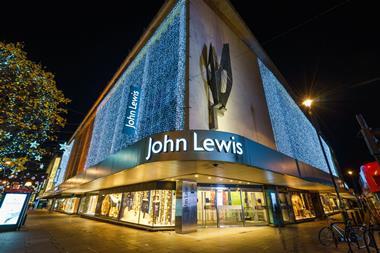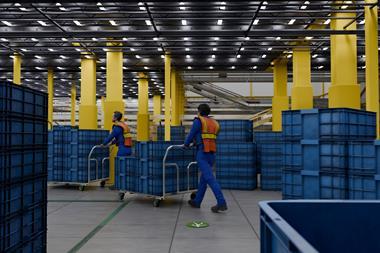Now more than ever, retailers and suppliers need to work together and be transparent, but a lack of trust is costing them, says Charlotte Hardie

“In today’s world you need to be as concerned about your suppliers’ profit and loss as your own,” Borders US chief executive Ron Marshall warned retailers at the World Retail Congress in Barcelona last month. At a time when supply chain efficiency is a priority and when many retailers’ suppliers are in unfamiliarly risky territory, being open about forecasts, sales, replenishment and promotions has never been more important.
Alan Braithwaite, chairman of supply consultancy LCP Consulting, says: “Everyone knows about the concept of transparency, but along the supply chain there are blocks where people perceive what they are being asked to do is against their short-term commercial interests. They think they’re going to get competitive advantage by keeping suppliers in the dark, when actually the reverse is the case.”
Part of the problem is that many retailers believe that every bit of information about their business is top secret. In many ways it is easy to see why - if the supplier knows exactly what stock the retailer needs to meet projected demand, for instance, the retailer is automatically in a weaker position. AlixPartners director Dan Murphy says: “The supplier would know when the retailer was bluffing and when they were desperate for stock.”
In reality though, being transparent brings significant commercial benefits that many retailers are not aware of. Braithwaite says: “If you can look beyond your own link in the chain you can often see an opportunity to work with suppliers in a way that often takes out cost and enhances performance.”
Forecasting is a good example of how providing more information would save, not lose, everyone money. Retailers want to know that the stock is there if they need it but also like to keep their suppliers on their toes, so are reluctant to share information about forecasting. Murphy says: “It’s a case of: ‘I might want this amount of product, and if I do, I want you to have it there, and if I don’t, I don’t want to have a piece of paper that says that I do’.”
However, this approach means many suppliers are forced to keep buffer volumes of stock just in case they need it for their retail customers. This excess product in turn creates cost, which is often reflected in suppliers’ cost price. So retailers are paying the price for their lack of transparency, even if it’s not immediately obvious.
Aurora distribution director David Roberts also points out that in some cases being more transparent might actually aid negotiations with suppliers. “It might be that if the retailer promises to give the supplier a lot more information and, say, guarantees production runs, then the supplier might be more willing to negotiate a discount.”
The best practice approach
Roberts says Aurora certainly does recognise the importance of being open with its suppliers. “In the supply chain world we try and act as a catalyst for improving the quality of our business. The thing we are all trying to avoid is wasted resources and the only way to do that is by sharing information.”
He adds: “How can you expect someone to deliver if you don’t give them as much information as possible? It’s about keeping them in the loop rather than expecting them to deliver something that they didn’t know was expected of them.”
Interestingly, those retail businesses that do openly share information with their suppliers are often among the most successful. Braithwaite says that the big discount retailers are particularly noted for the huge amount of work they have done in terms of understanding suppliers’ costing. “They can see the entire margin structure,” he says.
Simon Showman, chief executive of Ultimate Products, which supplies stock to retailers such as Tesco, Argos and John Lewis, says: “I find that the biggest and the best retailers are transparent.” He points to Tesco and Argos as two examples. “Tesco is fair and open and the same goes for Argos.
I often hear people say that Argos is difficult to work with but, actually, Argos knows that if it works with our merchandisers constantly and its forecasting is good, it doesn’t get left with stock. If you are working together you are not over-ordering, so you have fewer markdowns.”
For those retailers that do want to bring about a more transparent culture, what should they do? Braithwaite recommends looking at where the retailer most needs to drive value and then engaging the supplier not just in the hard commercial negotiations but where they could align their businesses better.
Retailers should also be wary about leaping head first into the much-heralded Collaboration, Planning, Forecasting and Replenishment (CPFR) way of working. These involve adhering to a collaborative approach within an organisation, backed up by technology that co-ordinates various supply chain activities such as production, purchase planning, demand forecasting and replenishment.
In an effort to lift their supplier collaboration credentials, many retailers like to publicise that they are proponents of CPFR. The trouble is, in many cases retailers simply pay lip service to it. In addition, many retailers have gone out and spent millions of pounds on systems that would enhance transparency, but there is no commitment to making it work. No amount of technology can bring about transparency unless the teams involved actually buy into it.
There is also the risk of suddenly embarking on a flurry of supplier transparency activities, only for efforts to lose momentum within a matter of months. This creates confusion
and can fuel suspicion among suppliers, jeopardising any future collaborative opportunities.
Transparency also needs to be carefully thought through in order to get it right from the outset. Braithwaite says: “There is a huge amount of information to process and to get well ordered. It’s a challenge for suppliers, particularly when aligning to different customer processes. The difficulty is that if it doesn’t work out the first time, the supplier will be more reticent in the future.”
Historical problems
The primary reason why so many businesses are reticent to adopt a culture of transparency is because the retailers and suppliers have historically viewed themselves as two entirely different breeds of people. Quite simply, it is a very difficult outlook to alter. Braithwaite says: “It’s a different mindset and people certainly aren’t trained to be transparent.”
Murphy says: “When Ghandi was asked what he thought of Western civilisation, he said he thought it would be a very good idea. It’s the same for collaboration between retailers and suppliers.” He adds: “Many retailers like the upper hand. They like the power of being able to cancel deliveries, increase discount rates, force suppliers to fund markdowns and promotions. These things do not fit with collaboration, so it doesn’t happen.”
Even though the two parties are part of the same chain and are dependent on each other, there is often still very much a “them and us” mentality. There is only a certain amount of margin available, and both are doing all they can to retain what they can.
Although retailers have the power over suppliers, many suppliers are often equally reluctant to be open about certain information. Some can be far from accurate about lead times and the cost of production, for instance, but if the relationship is strained, they can’t afford to give accurate information.
Many retailers do recognise the importance of transparency, but many more businesses would benefit from a culture change. The present vulnerability of suppliers is a problem for retailers. The closer the two work together, the more aware the retailer will be if their supplier is running into difficulty. If retailers want to minimise risk and maximise savings then transparency is something that they can no longer afford to put on the back-burner.


























No comments yet